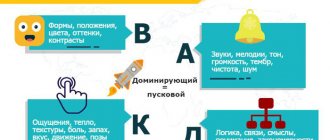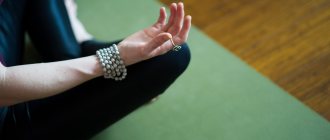A person continuously receives information from the world around him, and this happens through five channels of sensitivity: vision, hearing, taste, smell and touch. In the process of human development, there is a gradual predominance of one sensory system over another. In most cases, a person receives and processes visual information first. Therefore, people in whom this sensory system dominates are called “Visual”.
Visual learners are people who have a very active visual-associative brain function. In other words, a visual person is someone who “feels with their eyes” and remembers visual images better.
Good people are strong people. Andrey Nikolaevich Kochergin
Differences between people by psychotype
I once observed a married couple at my psychological appointment. She is a well-groomed, slender, hair-to-hair blonde, with a taut back. Having aligned her legs in high heels evenly to each other, this beauty - a woman with her head held high - gracefully sat on the edge of the chair. “A very uncomfortable, but impressive-looking pose,” I thought.
And he is a heavy, squat, middle-aged man in a stretched sweater and wide jeans, unshaven, and sloppy-looking. At the same time, unlike his wife, who demonstrated an ideal appearance, he conveyed with his whole being a feeling of freedom: in an open, relaxed position, he sat on the sofa closer to the window and breathed regularly, taking in fresh air.
He enjoyed the process, his stomach rising high with each deep breath. And it seemed to me that, perceiving the monologue of his indignant wife through a phrase, he was already dozing, wrapped in a feeling of comfort.
Couple at a psychologist's appointment
“What a beauty!” my professional rejoiced inside. There are two opposing psychotypes from the category “Leading representative system in humans” - VISUAL and KINESTHETIC. And each of them is sure that their partner deliberately irritates him, causes vivid negative emotions, figuratively speaking, “makes his life unbearable.” Is this so? And how exactly do they differ?
Work for the visual
The skill of thinking in images and vivid pictures finds its application in a variety of creative fields. The professions of photographer, designer, illustrator, artist, constructor, fashion designer, stylist, sculptor are suitable for visual people. He can spend hours contemplating various phenomena, objects, or other people, making sketches of them. This psychotype is characterized by a desire for beauty and harmony. Unlike connoisseurs of convenience - kinesthetics, visual learners prefer trends. It is thanks to their efforts that fashion is constantly changing, with some styles and palettes being replaced by others.
In the era of rapid development of social networks and widespread blogging, visuals have gained new power. The entire industry built around Facebook, Instagram, YouTube or TikTok is aimed at beautiful pictures or spectacular videos. The bulk of SMM specialists are most likely from the fraternity of visualists. Although, analytical thinking in this area is also necessary, especially when it comes to targeted advertising, selection of target audiences, and further interpretation of statistical data. Discretionaries excel at this. But pure psychotypes are not so common. So, effective SMM workers are visual people with a slight touch of “discreteness”.
The gaming industry and cinema are no less connected with visual perception. Beautiful, bright, rich images of the main characters or villains are created by people with imagination. Iconic characters like Jack Sparrow, Master Yoda, Shao Kahn, Shredder or even Pikachu, appeared precisely thanks to the developed imagination of their creators. It is difficult to say what the world would play or what films it would watch if there were only auditory, discrete and kinesthetic learners on our planet.
The concept of “REPRESENTATIVE SYSTEM”
When interacting with the world around us, we receive information about it through sensory channels (representational systems) - visual, auditory, kinesthetic and discrete (logical).
A science such as NLP (neurolinguistic programming), by studying oculomotor reactions (trajectory of movement of a person’s eyeballs), analyzing speech predicates, coupled with the study of his postures and gestures, very effectively determines the leading representative system of a person.
Recommended on the topic: You don’t owe anyone anything. Except for yourself... Is this so? Components of the Self
This is the dominant sensory channel through which information about the environment enters the human brain.
Perception test: auditory, visual, kinesthetic, discrete?
Author of the material:
Inna Trofimova
writer, psychologist, gestalt therapist
With this test you can determine the leading source of information perception. Classically, 3 types were distinguished: visual, auditory and kinesthetic . In modern approaches, another type is distinguished - discrete . So let's find out who you belong to. The test has 30 questions, you must answer all of them. Remember that there are no right or wrong answers in the test, answer quickly - the answer that comes to mind first is the true one.
1. What you remember best is:
2. Have you ever vacationed at sea in the summer? Remember your impressions. What comes to your mind first?
3. Remember your “last call” at school. What comes to your mind first?
4. I consider myself:
5. When I am asked an important question:
6. When talking with your opponent, what affects you most is:
7. It’s easier for me to collaborate with people I like:
8. You have an old but favorite thing. You want to wear it, but it already looks really bad:
9. You need to make an important decision. What is most important to you in this case?
10. You most understand yourself and what you want when:
11. What is important to you when talking with other people:
12. When buying a new mobile phone, what do you pay most attention to?
13. Have you dreamed of participating in the creation or filming of films? What would you like to do:
14. Remember your impressions when you walked through the autumn forest. What comes to your mind first?
15. When working with other people, what I want most is:
16. You...
17. What do you consider the best birthday gift for yourself:
18. When something is explained or described to me, I learn best if:
19. I open up best to people when they are able to:
20. What guides you when you are about to make an important decision:
21. What is best remembered in your head:
22. How do you feel about dancing:
23. Remember a party in a cafe with friends. What comes to your mind first?
24. When receiving new information, it is important for you first of all:
25. Based on what you make decisions:
26. When you are in conflict with another person, what touches you most:
27. Easiest and simplest for you:
28. The hardest things for me in stressful situations are:
29. I consider it natural and simple for a person when he
30. What do you think is the best way to communicate with friends:
Additional Information:
- Test for Eysenck's temperament type online
- Test for the leading subpersonality: child, adult, parent?
- Personality type test
- Test for introvert and extrovert
- Character test
- Test optimist or pessimist?
- Brain hemisphere test
Article:
A person perceives and also shares information in three ways: through sounds, images and movements.
Depending on which option is used by people most often, they are divided into three groups according to types of perception. These are: – auditory learners;
– visuals;
– kinesthetics
And since internal dialogue, working with words and numbers, is added to external perception, a fourth group is conventionally distinguished. This:
– digitals.
There are practically no people who use only one channel. So we all represent mixed types of perception. Let’s try to understand in more detail what the difference in the perception of information is.
Speak and I will recognize you
Auditory learners perceive this world by ear. Sounds are the most important source of information for them. They have excellent hearing and excellent memory. They love not only to listen, but also to talk. Moreover, it is undesirable to interrupt them, as they may become offended and withdraw into themselves.
What does the audio look like?
As a rule, they have an upright posture with a slight forward lean. The chest is often well developed. Their voices are very expressive, pleasant, melodic. When speaking, auditory learners do not like to make eye contact; this prevents them from listening. When listening to the interlocutor, people with this type of perception often tilt their heads slightly to the right and cross their arms over their chest.
Auditory speech
They often use words and expressions related to sound perception. For example:
- listen;
- sounds tempting;
- harmonious;
- what a mysterious tone;
- sounds great;
- glad to hear it.
Auditory people are precisely those people who love with their ears, so talk to them at every opportunity, say pleasant words and listen to them very carefully, they are very upset if they are “not heard.”
I can see everything - so you know
People who perceive most information through vision are called visuals .
They are dreamers, as they can perfectly imagine various pictures and scenes. At the same time, people who plan everything clearly. It is not difficult for them to divide work between employees and draw up strategies. They also prefer visual reports and love when “everything is beautiful.”
What does the visual look like?
His appearance is always on point. These people do not allow themselves to dress sloppily. They are capable of choosing uncomfortable clothes just to look attractive.
Visual people have a keen eye and a high-pitched voice. They gesture a lot, as if showing what they are talking about. At the same time, their gestures are directed away from themselves and horizontal.
They usually stand and sit upright, and if they slouch, they lift their heads up. Their gaze is usually directed upward. At the same time, they always look at the interlocutor and demand the same from him. Visualizers often have slightly raised eyebrows.
Visual speech
When speaking, they often use words related to visual perception:
- it looks;
- look what it is;
- it will be visible there;
- you see;
- I see.
These people prefer to be at a distance from the interlocutor in order to get a better look at him and cannot stand touching or hugging. They love with their eyes.
I won't believe it until I touch it
People who perceive the world through movement, smell and touch are called kinesthetics .
These are people of action who just need to smell, taste and touch everything. They do not perceive information if it cannot be put to use immediately and carry out what they have learned.
Kinesthetic learners are very receptive, as they let everything pass through them. They do not know how to hide their feelings and often hide their eyes, which give them away.
What do kinesthetics look like?
They dress in comfortable clothes, the appearance of which is not very important to them. As a rule, they have a dense physique. They most often have full and wide lips.
They often slouch, stand and sit leaning forward. They try to be as close to the interlocutor as possible in order to be able to touch him during communication.
Kinesthetic learners move smoothly. The gaze is almost always directed downwards.
Speech kinesthetics
People of this type of perception prefer to use words and expressions that describe movements and feelings. You can often hear from them:
- I feel (feel) this way;
- hand in hand;
- keep calm;
- make contact;
- to catch something;
- control yourself.
Kinesthetic people are happy people. They love to touch.
We immediately see the meaning and essence
It would seem that we have considered all the channels of information, which means that you can simply take a test for the type of perception and find out who your baby is, but it’s worth finding out about one more type.
People who perceive information through logical comprehension, with the help of signs, numbers and logical arguments, are called digitals.
For them, meaning and functionality are most important. The digital channel controls speech, therefore people of this type of perception are focused on words. They are able to create documents that do not contain ambiguous language.
What does digital look like?
They have a stiff, upright posture, monotonous speech, and virtually no gestures. They prefer to look at the interlocutor's forehead, or over his head. They don't like to be touched. Although outwardly they resemble kinesthetics. These types of perception are very close. Moreover, digitals are precisely obtained from hypersensitive kinesthetics. When feelings become too strong, a person tries to distance himself from them, to retreat into reasoning.
Digital speech
When communicating, digitals can often use the following expressions:
- let's think;
- if you think sensibly;
- thinking logically.
And the internal dialogue of digital is replete with the following expressions:
- or I was wrong;
- I did something wrong;
- I’ll answer him next time;
- why did he call me that?
He loves digital with his mind.
Visual, kinesthetic, auditory - who is it? article
Psychological article
Visual, kinesthetic, auditory - who is it?
Visual, auditory, kinesthetic, discrete - these words mean the peculiarity of perception and processing of information by people of different ages:
- Visual – perceives most information through vision;
- Auditory – receives basic information through hearing
- Kinesthetic – assimilates information through other senses (smell, touch) and through movements
- Discrete - perceives information through logical comprehension, using numbers, signs, logical arguments. This category of people is the least common, and children, including schoolchildren, are usually not discrete.
Such features of the psyche (perception and processing of information) appear already in preschool age and play a big role in establishing contacts between the child and the people around him, in the success of learning, and acquiring new skills and abilities.
To recognize a preschooler’s leading channel for perceiving and processing information, it is often enough to simply observe.
Visual preschooler
When perceiving information, the child relies more on visual sensations. He quickly remembers color, shape, size. If you offer your baby a new toy, he will first carefully examine it from all sides. Visual children love to sculpt, draw, cut out, and put together puzzles. Their activities and games involve interaction between their eyes and hands. Such children prefer to look at pictures in a book than to listen to a fairy tale (for example, on an audio cassette or performed by their mother).
For visual children, it is important what they are wearing; they themselves choose the color of tights, shorts, and blouses. Girls are sensitive to jewelry, hairpins and bows. A visual child will first remember and tell you who came to kindergarten in what today, and who had the brightest toy on the playground. The visual is quite neat (for its age), for example, it will not get into a puddle, because the shoes will be dirty and ugly.
When communicating with peers, a visual child first observes, and only then makes contact (joint play); he can play alone for a long time. When raising a visual child, it is necessary to pay attention to the development of speech (he is not talkative), communication skills (the ability to communicate), and physical coordination.
Preschooler-auditory
He learns about the world around him through sounds, so he begins to speak earlier than others and has a large vocabulary. Such a kid loves to listen to music, audio recordings of fairy tales, to have conversations - to discuss, to prove. Auditory learners come up with various fairy tales and games. They know how to convince and persuade. But they don’t like to participate in outdoor games. Auditory children are very sociable. They may lag slightly behind their peers in the development of skills related to visual perception (find the difference in pictures, look carefully) and motor perception (the ability to dexterously climb a hill, run quickly and for a long time). Therefore, it is worth developing these skills through games and exercises.
Kinesthetic preschooler
A little kinesthetic learner explores the world through touch and movement. His motor skills are well developed, he moves a lot, and usually starts walking earlier. Such a child loves active games involving buckles, running, wrestling; it is difficult for him to sit in one place or do one thing for a long time. A kinesthetic baby loves to touch and feel everything; Tactile sensations are especially important to him, so caress him more often, cuddle him, try to use less of your favorite parental phrase “Don’t touch!”
Several more ways to recognize a preschooler’s leading channel for perceiving and processing information.
ACTIVE DICTIONARY. Visual learners in their speech use nouns, verbs, adjectives related to vision (look, observe, picture, at first glance, colorful, bright, as you see, etc.). Auditory is characterized by words associated with auditory perception (voice, listen, discuss, silent, silence, silent, etc.). The kinesthetic vocabulary mainly includes words that describe feelings, sensations (grasp, soft, warm, silky, touch, good smell, fragrant, flexible, etc.).
DIRECTION OF VIEW. When communicating, visual learners look primarily upward, auditory learners look along the midline, and kinesthetic learners look downward.
FEATURES OF ATTENTION. It is generally difficult for a kinesthetic person to concentrate his attention; he is easily distracted by anything. Auditory learners are easily distracted by sounds. The noise practically does not interfere with the visual performance.
FEATURES OF MEMORY. The visual person remembers what he saw, remembers pictures (imaginative thinking is well developed). Auditory – what was discussed is remembered by listening. A kinesthetic person remembers the general impression, remembers by moving, feeling, smelling.
Recommendations
Of course, when raising and teaching a child, it is necessary to take into account his peculiarities of perception and processing of information. It is important to communicate with the child “in his language.” If you need to make a note:
- For the visual, it’s better to shake your head and wag your finger;
- To the auditory say in a whisper “sh-sh-sh”, “hush”;
- Kinesthetics put your hand on your shoulder.
When a child performs any task (logical task, riddle, various developmental tasks and activities)
- The visual student is allowed to have a piece of paper at hand on which he can draw, hatch, draw, etc. while working;
- The auditory learner should not make comments when he makes sounds or moves his lips during the process of memorization;
- Kinesthetics should not be forced to sit still for a long time, give the opportunity for motor discharge (go to another room, stand up and jump).
Learn to understand each other, and you will have as few problems as possible!!!
To make communication with your child even more effective, use visual words that describe the color, shape, and location of objects; You can highlight points in the book with color, use tables, diagrams, and visual aids. Voice variations (volume, pauses, intonation) will help the auditory learner. Allow the kinesthetic learner to “play out” the information - use gestures, touches, and rather slow speech.
Any person, including a child, uses different channels of perception, that is, none of us can be only visual, only kinesthetic, etc. Peculiarities of perception also depend on age: young children tend to want to touch and taste everything, but by older preschool age, children more often begin to use their hearing and vision.
O.V. Anisimovich. Helping parents raise their children.
Conversations with a psychologist, 2009











